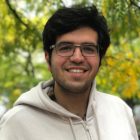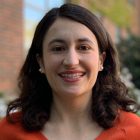Pasquale is a PhD student in aerospace engineering. He is developing general-purpose tools for estimation that are robust to corrupted information and adversarial attacks, run in real-time, and require minimal tuning. His interests include safe and trustworthy perception with application to single and multi-robot autonomous systems. He uses MATLAB on a regular basis, including the Computer Vision Toolbox and Robotics System Toolbox for his work on robust estimation. He earned his SB in computer science from University of Pisa, Italy, an SM in embedded computing systems from Scuola Superiore Sant’Anna of Pisa, Italy and an SM in aeronautics and astronautics from MIT. Prior to MIT, he was a research scientist at the United Technologies Research Center, Ireland.
https://engineering.mit.edu/wp-content/uploads/Antonante-Pasquale.jpg
Website
Pasquale Antonante
Aeronautics and Astronautics https://engineering.mit.edu/fellows/pasquale-antonante/Alireza is a PhD student in the Department of Electrical Engineering and Computer Science. His research is focused on developing new robust and accelerated optimization methods for machine learning applications. He uses MATLAB to tune algorithms to achieve the desired trade-off between convergence rate and robustness, making use of CVX to find the best set of parameters. With the Symbolic Math Toolbox, Alireza is also able to propose a specific parameterization by solving a set of matrix inequalities. He also works on characterizing the convergence properties of a class of meta-learning algorithms and its applications in other domains such as federated learning. In that regard, he uses MATLAB to certify the theoretical results through numerical experiments over both real and synthetic data sets. Alireza earned a BSc in electrical engineering and a BSc in mathematics from Sharif University of Technology, Iran.
https://engineering.mit.edu/wp-content/uploads/Fallah-Alireza.jpg
Website
Alireza Fallah
Electrical Engineering and Computer Science https://engineering.mit.edu/fellows/alireza-fallah/James is a PhD student in mechanical engineering. He is currently developing a suite of software tools to simulate underwater propulsion. In his research, he uses discrete elastic rods (a differential-geometry based discretization) to simulate materials with a time-dependent resting state. James uses MATLAB’s sparse matrix tools to evolve this model with implicit time integration, increasing the maximum allowable time step in dynamic simulations. In the simulation of two-dimensional elastic membranes, MATLAB’s automatic vectorization allows James to create code in a speed-critical environment. Finally, he models simplified fluid flows with a time-dependent boundary element method that relies on MATLAB to produce vectorized code for long-range interactions. James earned an SB in mechanical engineering and applied and computational mathematics from University of Southern California.
https://engineering.mit.edu/wp-content/uploads/Gabbard-James.jpg
Website
James Gabbard
Mechanical Engineering https://engineering.mit.edu/fellows/james-gabbard/Nicolas is a PhD student in neuroscience within the Medical Engineering and Medical Physics program at Harvard-MIT Division of Health Sciences and Technology. His research is focused on cortical dynamics in adaptive sensorimotor behavior. He regularly uses MATLAB to look at slices of neural trajectories along specific dimensions in order to understand what part of brain activity can be related to a behavior of an individual. He visualizes brain activity as it unfolds in time and performs more advanced analyses of the detailed features of the dynamics and geometry of the neural trajectories. Nicolas earned an MS in aerospace engineering from California Institute of Technology and an BS and MS in aeronautics and astronautics from ISAE-Supaero, France.
https://engineering.mit.edu/wp-content/uploads/Meirhaeghe-Nicolas.jpg
Website
Nicolas Meirhaeghe
Institute for Medical Engineering and Science https://engineering.mit.edu/fellows/nicolas-meirhaeghe/Caroline is a PhD student in chemical engineering. She uses MATLAB to implement and test new applications and advances in non-smooth analysis. She also intends to use MATLAB to develop methods to simultaneously minimize resource use and perform process optimization for other objectives, such as minimal operating costs. She earned a BS in engineering from Harvey Mudd College and an SM in chemical engineering from MIT.
https://engineering.mit.edu/wp-content/uploads/Neilsen-Caroline.jpg
Website
Caroline Nielsen
Chemical Engineering https://engineering.mit.edu/fellows/caroline-nielsen/Bauyrzhan is a PhD student in civil and environmental engineering working on interfacial fluid dynamics problems in porous media. Bauyrzhan develops computational models to study how wettability changes fluid displacement patterns in porous media. He also turns computer fans into capillary-tube spin coaters, which he controls with MATLAB’s Arduino Support, and he studies moving-contact-line problems with the help of MATLAB’s image acquisition and processing tools. Bauyrzhan earned a BS in petroleum engineering and MS in chemical engineering from the University of Alberta, Canada.
https://engineering.mit.edu/wp-content/uploads/Primkulov-Bauyrzhan.jpg
Website
Bauyrzhan Primkulov
Civil and Environmental Engineering https://engineering.mit.edu/fellows/bauyrzhan-primkulov/Kate is a PhD student in materials science and engineering. Her research is focused on understanding the coupling and interfacial phenomena between two-dimensional (2D) layered materials and their 3D bulk material adjuncts for the continued and rapid development of devices that utilize 2D materials. She has used MATLAB to process in situ transmission electron microscopy (TEM) videos, as well as to analyze 2D material thickness and absorption resonances. This provides her with dynamic information about materials growth and processing at the atomic scale. She earned a BS in nanoscience, physics, and chemistry of advanced materials from Trinity College, Dublin.
https://engineering.mit.edu/wp-content/uploads/Reidy-Kate.jpg
Website
Kate Reidy
Materials Science and Engineering https://engineering.mit.edu/fellows/kate-reidy/Isabelle is a PhD student in the Department of Civil and Environmental Engineering. Her research uses computational methods to understand and validate the mechanical properties of silk and spider webs that have been observed in biological experiments. She is currently developing an algorithm to accurately quantifies a 3D spider web geometry using the MATLAB Image Processing Toolbox. She has also used MATLAB to sonify 3D spider web data in order to visualize through sight and sound the complex structures and mechanics of webs. Isabelle earned a MS in building engineering from Ecole Spéciale des Travaux Publics, Paris and an MEng in high-performance structures at MIT.
https://engineering.mit.edu/wp-content/uploads/Su-Isabella.jpg
Website
Isabelle Su
Civil and Environmental Engineering https://engineering.mit.edu/fellows/isabelle-su/Joy is a PhD student in chemical engineering. Her research is focused on the electrochemical transformation of carbon dioxide to fuels and/or commodity chemicals. She is focused on cobalt phthalocyanine, a transition metal complex that when immobilized onto carbonaceous supports acts as a catalyst with high selectivity and activity for the electroreduction of carbon dioxide into carbon monoxide. She uses MATLAB to model the interplay between mass transport and reaction network kinetics to allow cohesive integration between molecular-level hypotheses and macroscopic experimentally measured reaction rates. Joy earned her BS in chemical engineering from Stanford University.
https://engineering.mit.edu/wp-content/uploads/Zeng-Joy.jpg
Website
Joy Zeng
Chemical Engineering https://engineering.mit.edu/fellows/joy-zeng/Benjamin is a PhD student in computational science and engineering. His research is focused on establishing a unifying framework for understanding and producing new computational methodology for rare event simulation, data assimilation, and Bayesian inference. He uses MATLAB to prototype new methods for rare event simulation, finding them by leveraging mathematical principles used in proofs and repurposing them for computation. Benjamin earned a BS in engineering physics and BA in applied mathematics from University of California at Berkeley and an SM in aeronautics and astronautics from MIT.
https://engineering.mit.edu/wp-content/uploads/Zhang-Benjamin.jpg
Website
Benjamin (Jiahong) Zhang
Electrical Engineering and Computer Science https://engineering.mit.edu/fellows/benjamin-jiahong-zhang/Paul is a PhD student in electrical engineering and computer science. His research is focused on developing high-quality meshes that are typically required to solve complicated partial differential equations numerically. He currently uses MATLAB to prototype frame field algorithms and to study their application to hexahedral meshing. More specifically, he uses MATLAB’s symbolic differentiation to derive vector calculus expressions and to create concise yet massively vectorized implementations of geometry processing algorithms like frame field combing. He also uses the MATLAB based rendering tool hexygen/SPRender for easy visualization and evaluation of the resulting frame fields. He earned his BS in computer science from California Institute of Technology.
https://engineering.mit.edu/wp-content/uploads/Zhang-Paul.jpg
Website